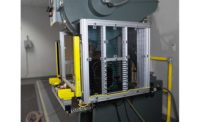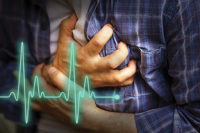AEDs 101: Covering the basics
National Institutes of Health answers to frequently asked questions

An automated external defibrillator (AED) is a portable device that checks the heart rhythm. If needed, it can send an electric shock to the heart to try to restore a normal rhythm. AEDs are used to treat sudden cardiac arrest (SCA). You often find AEDs in places with many people, such as shopping malls, golf courses, businesses, airports, airplanes, casinos, convention centers, hotels, sports venues, and schools. You also can purchase a home-use AED.
What is sudden cardiac arrest?
SCA is a condition in which the heart suddenly and unexpectedly stops beating. When this happens, blood stops flowing to the brain and other vital organs.
SCA usually causes death if it's not treated within minutes. In fact, each minute of SCA leads to a 10 percent reduction in survival. Using an AED on a person who is having SCA may save the person's life.
Ninety-five percent of people who have SCA die from it—most within minutes. Rapid treatment of SCA with an AED can be lifesaving.
What are arrhythmias?
The heart has an internal electrical system that controls the rate and rhythm of the heartbeat. With each heartbeat, an electrical signal spreads from the top of the heart to the bottom. As the signal travels, it causes the heart to contract and pump blood. The process repeats with each new heartbeat.
Problems with the electrical system can cause abnormal heart rhythms called arrhythmias (ah-RITH-me-ahs). During an arrhythmia, the heart can beat too fast, too slow, or with an irregular rhythm. Some arrhythmias can cause the heart to stop pumping blood to the body. These arrhythmias cause SCA.
The most common cause of SCA is an arrhythmia called ventricular fibrillation (v-fib). In v-fib, the ventricles (the heart's lower chambers) don't beat normally. Instead, they quiver very rapidly and irregularly.
Another arrhythmia that can lead to SCA is ventricular tachycardia (TAK-ih-KAR-de-ah). This is a fast, regular beating of the ventricles that may last for only a few seconds or for much longer.
In people who have either of these arrhythmias, an electric shock from an AED can restore the heart's normal rhythm. Doing CPR (cardiopulmonary resuscitation) on someone having SCA also can improve his or her chance of survival.
What are the signs of sudden cardiac arrest?
If someone is having SCA, you may see him or her suddenly collapse and pass out. Or, you may find the person unconscious and unable to respond when you call or shake him or her.
The person may not be breathing, or he or she may have an abnormal breathing pattern. If you check, you usually can't find a pulse. The person's skin may become dark or blue from lack of oxygen. Also, the person may not move, or his or her movements may look like a seizure (spasms).
An AED can check the person's heart rhythm and determine whether an electric shock is needed to try to restore a normal rhythm.
What do you do if you suspect someone is having a SCA?
Before using an automated external defibrillator (AED) on someone who you think is having sudden cardiac arrest (SCA), check him or her.
If you see a person suddenly collapse and pass out, or if you find a person already unconscious, confirm that the person can't respond. Shout at and shake the person to make sure he or she isn't sleeping.
Never shake an infant or young child. Instead, you can pinch the child to try to wake him or her up.
Call 9–1–1 or have someone else call 9–1–1. If two rescuers are present, one can provide CPR (cardiopulmonary resuscitation) while the other calls 9–1–1 and gets the AED.
Check the person's breathing and pulse. If breathing and pulse are absent or irregular, prepare to use the AED as soon as possible. (SCA causes death if it's not treated within minutes.)
If no one knows how long the person has been unconscious, or if an AED isn't readily available, do 2 minutes of CPR. Then use the AED (if you have one) to check the person.
After you use the AED, or if you don't have an AED, give CPR until emergency medical help arrives or until the person begins to move. Try to limit pauses in CPR.
After 2 minutes of CPR, you can use the AED again to check the person's heart rhythm and give another shock, if needed. If a shock isn't needed, continue CPR.
How do you use an AED?
AEDs are user-friendly devices that untrained bystanders can use to save the life of someone having SCA. The AED has step-by-step instructions and voice prompts that enable an untrained bystander to correctly use the machine.
Before using an AED, check for puddles or water near the person who is unconscious. Move him or her to a dry area, and stay away from wetness when delivering shocks (water conducts electricity).
Turn on the AED's power. The device will give you step-by-step instructions. You'll hear voice prompts and see prompts on a screen.
Expose the person's chest. If the person's chest is wet, dry it. AEDs have sticky pads with sensors called electrodes. Apply the pads to the person's chest as pictured on the AED's instructions.
Place one pad on the right center of the person's chest above the nipple. Place the other pad slightly below the other nipple and to the left of the ribcage.
Make sure the sticky pads have good connection with the skin. If the connection isn't good, the machine may repeat the phrase "check electrodes."
If the person has a lot of chest hair, you may have to trim it. (AEDs usually come with a kit that includes scissors and/or a razor.) If the person is wearing a medication patch that's in the way, remove it and clean the medicine from the skin before applying the sticky pads.
Remove metal necklaces and underwire bras. The metal may conduct electricity and cause burns. You can cut the center of the bra and pull it away from the skin.
Check the person for implanted medical devices, such as a pacemaker or implantable cardioverter defibrillator. (The outline of these devices is visible under the skin on the chest or abdomen, and the person may be wearing a medical alert bracelet.) Also check for body piercings.
Move the defibrillator pads at least 1 inch away from implanted devices or piercings so the electric current can flow freely between the pads.
Check that the wires from the electrodes are connected to the AED. Make sure no one is touching the person, and then press the AED’s “analyze” button. Stay clear while the machine checks the person's heart rhythm.
If a shock is needed, the AED will let you know when to deliver it. Stand clear of the person and make sure others are clear before you push the AED’s “shock” button.
Start or resume CPR until emergency medical help arrives or until the person begins to move. Stay with the person until medical help arrives, and report all of the information you know about what has happened
How does an AED work?
Automated external defibrillators (AEDs) are lightweight, battery-operated, portable devices that are easy to use. Sticky pads with sensors (called electrodes) are attached to the chest of the person who is having sudden cardiac arrest.
The electrodes send information about the person's heart rhythm to a computer in the AED. The computer analyzes the heart rhythm to find out whether an electric shock is needed. If a shock is needed, the AED uses voice prompts to tell you when to give the shock, and the electrodes deliver it.
What is proper training and maintenance of an AED?
Learning how to use an AED and taking a CPR (cardiopulmonary resuscitation) course are helpful. However, if trained personnel aren't available, untrained people also can use an AED to help save someone's life.
Some people are afraid to use an AED to help save someone's life. They're worried that something might go wrong and that they might be sued. However, Good Samaritan laws in each State and the Federal Cardiac Arrest Survival Act (CASA) provide some protection for untrained bystanders who respond to emergencies.
Facility owners who are thinking about buying an AED should provide initial and ongoing training to likely rescuers (usually people who work in the facility). Also, they should properly maintain the AED and notify local emergency officials of its location.
What are the risks of using an AED?
Automated external defibrillators (AEDs) are safe to use. There are no reports of AEDs harming bystanders or users. Also, there are no reports of AEDs delivering inappropriate shocks.
If someone is having sudden cardiac arrest, using an AED and giving CPR (cardiopulmonary resuscitation) can improve the person's chance of survival.
Looking for a reprint of this article?
From high-res PDFs to custom plaques, order your copy today!








